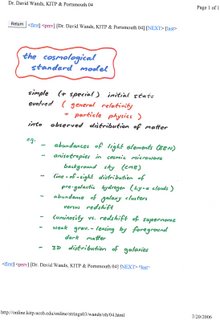Well the very idea that such a thing could exist, has been part of the evolving information I had been going through. To be lead to the understanding, of what new Physics would emerge fromm cosmological and collidial events. That there are indeed showers of particles with which such events will let us know cannot be ignored.
First Principle needed to recognize "the very state" that things would arise from. For Robert Laughlin, a condense matter theorist, it didn't mater what you called these building blocks, but any discrete measure had to be recognized it's energy value and tragectories would it not? Hence, the particle shower from a known state of existance, where "first principle" would emerged.
So, any attempt to ignore the possibility of what emerges, and the foundational perspective, put forth in theory, has to help the understandng of what happens when such events do happen, either, micro perspectively or cosmologically.
Any attempts to say that the standard model is not inclusive in this design, would be detrimental to the very statement any mathematican would say against, that simply erasing any connection, would have been futile to their creditbility?
Strange Quark Matter TheoryTamas S. BiroLadies and gentlemen, this is going to be the theoretical summary talk of the Strange Quark Matter 2003 conference. When I was alerted by the e-mail we all got, “prepare your transparencies”, I took this home-work exercise seriously. I have prepared quite a few pages before this conference. What can one know in advance, before listening to the talks?.
First of all there is a general outline which a summary talk should follow. On the level of the basic theory one is supposed to conclude about the present status of the underlying theoretical concepts, one ought to emphasize important news, the novel aspects we are encountering, and finally it is useful to formulate in a possibly definite way, what our perspectives for further development are.
So given the research that I had been going through, what is this strangelet subject that was developed, and I will post links that support the development of the fear with which such a thing arose. Was answered, by cosmological and collidial production of microstate blackhole events. Might the story and television series of blackholes been interrupted by such a dialogue, or had I furthered the plot for public consumption? To continue the fear?
Would your scientist/mathematican friend tell you about such things and ways in which to expect information from experimental designs, as not leading into the desire of the essence of new physics?
What began this assumption, was the idea that microstate blackholes were something of a danger, if we were to created them. That was the nightmare. The reality is, that this theoretically written state, is quite useful in terms of what can emerge from the idea of new physics, and had to include the standard model.
To get to new physics you had to have the standard model as a basis, and to move from that point, any resulting shower and new information, like in ICECUBE, along with the historiy and research of neutrinos, points to what? Strangelets to what?
Peter Woit dissassociated himself from that possibility, and if strings was to underly this view, what says, such advancements had not adhered to the demands of theoretcial proposition, that it now sees itself, as part and parcel of the planning for what else will emerge? Sees itself immersed in tachyon demonstration as a sign of cerenkov radiation as that blue light?
So indeed I struggle with how such theorectical position might have told me what is going on, and this issue, is not to be ignored as long as it is remianing consistant with the developement from standard model presumptions.
Paul first, and then I had been wondering about this issue right back in the beginning as it came to our attention. Steinberg and clarifications on what the microstate balckhole is was important, as it demonstrates the basis of work being done taking the energies and collidial events, to a new level of reductionistic perception. The microstate blackhole is the basis as far as I can tell.
Now given the state of Quark Gluon Plasma, what happens when you see such things hhappeniing that you have to aassume a new theoretcial position like M theory that such D Brane assumptions talk abut the viscosity nature? What are the poperties that have emerged from the idea of the blackhole, as this new state of matter tells us something about superfluids and such?
Does Peter understand these new developments? Does his own theoretical position from model assumption he also used, have correlates to current day information and research? It had been my hope, that his position would have created the dialogue necessary. I have enjoyed the mathematical adventures he has shown has developed further my perspective as shown, in the very last link below.
In order to have the perspective and vision of the abstract world of the mathematics shown, you needed to know some things. They had to be couched in the history of all that we have learnt, and any modification in mathematical language, alters that perspective, if it relates to the very work you are doing on extending the standard model?
See:
Quark Gluon Plasma II Strangelets Form Gravitonic Concentrations Strangelets in Cosmic Consideration Cosmic Rays Collsions ad Strangelets ProducedQuark StarsAccretion Disks Evidence for Extra Dimensions and ICECUBEAll Particle of te Standard Model and Beyond

